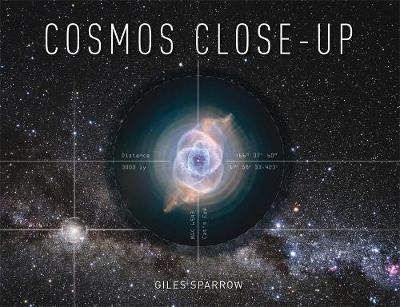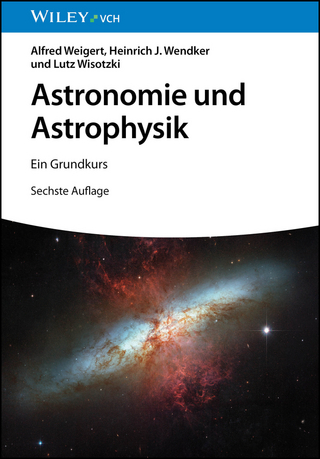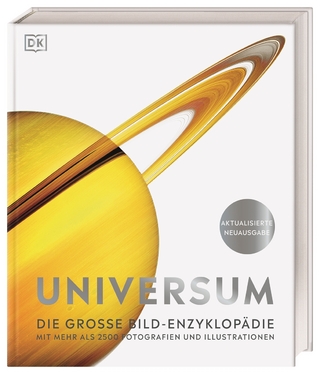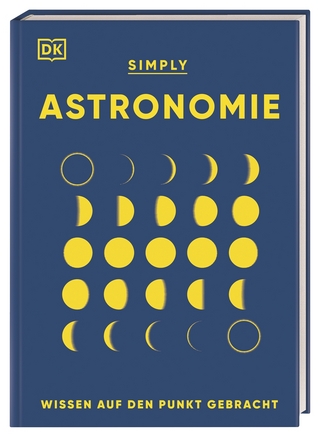
Cosmos Close-Up
Quercus Publishing (Verlag)
978-0-85738-345-7 (ISBN)
- Titel ist leider vergriffen;
keine Neuauflage - Artikel merken
Using a wealth of high-resolution images collected by a fleet of telescopes, satellites and inter-planetary probes, Cosmos Close-up embarks on a voyage across the universe, pausing only to zoom in on the most spectacular planets, stars, galaxies and nebulae. After a fly past of our planetary neighbours we reach the edge of the solar system - a mere 15 light hours away - emerging into interstellar space and heading for the heart of our galaxy. The rhythms of stellar life unfold before our eyes: dark clouds of dust and gas blaze with clusters newly smelted stars, dying stars bloom and fade as planetary nebulae, or tear themselves apart as supernovae. Navigating through thick swarms of stars, we reach the galactic core, a gravitational maelstrom of exotic stars in the thrall of a supermassive black hole. Hundreds of thousands of light years must be covered to reach the Milky Way's companions, the Large and Small Magellanic Clouds, and millions more devoured before we cross true intergalactic space. Out here we watch the hidden lives of galaxies: we see them locked in gravitational combat, tearing each other apart or swallowing their companions whole.
Now billions of light years from Earth, we can discern the large-scale structure of the universe: massive conglomerations of galaxies gather like grains of dust on a veil of cobwebs, warping space with their tremendous gravity. Having crossed an almost unimaginable 13.4 billion light years, we encounter a wall of radiation. Here our voyage into the cosmos must finally end, for we have reached the very edge of the visible universe: what stands before us is the afterglow of the Big Bang itself.
Giles Sparrow studied Astronomy at University College London, and works as an editor specializing in popular science. He is the author of - amongst other books - The Genius Test, The Universe and How To See It, The Stargazer's Handbook and Hubble: Window on the Universe and was a major contributor to Dorling Kindersley's Universe.
Introduction. Zooming in on the Universe. THE SOLAR SYSTEM: Introduction; Earth - Ocean planet; Earth - Tectonic crust; Earth - Mountain building; Earth's Moon - Sea of Tranquillity; Earth's Moon - Tsiolkovsky crater; Earth's Moon - The Lunar Apennines; Earth's Moon - Copernicus crater; The Sun - Our local star; The Sun - Surface activity; The Sun - Sunspots; Mercury - Caloris Basin; Mercury - Volcanic activity; Mercury - Shrinking planet; Venus - A volcanic world; Venus - Surface craters; Venus - Equatorial rifts; Mars - Valles Marineris; Mars - Olympus Mons; Mars - Polar ice; Mars - Victoria crater; Mars - Floodplains and rivers; Phobos; Asteroid 433 Eros; Asteroid 21 Lutetia; Jupiter - Atmosphere; Jupiter - Great Red Spot; Jupiter - Smaller spots; Io - Loki volcano; Io - Boosaule Montes; Europa - Icy crust; Europe - Mobile surface; Ganymede - A giant moon; Ganymede - Impact target; Callisto - Cratered moon; Saturn - Atmosphere; Saturn - Stormy weather; Saturn's rings - Fine structure; Saturn's rings - Particles; Mimas; Enceladus - Frosted world; Enceladus - Icy outbursts; Tethys; Dione; Rhea; Titan - Mysterious moon; Titan - Descent to the surface; Titan - Methane lakes; Hyperion; Iapetus - Moon of two halves; Iapetus - Equatorial ridge; Phoebe; Uranus; Rings of Uranus; Miranda; Neptune - Planet of storms; Neptune - High-speed clouds; Triton - An ice dwarf up close; Triton - Ice geysers; Pluto; Halley's Comet; Eris. OUR GALAXY: Introduction; Dark nebulae; Carina Nebula 1; Carina Nebula 2; Carina Nebula 3; Orion Nebula 1; Orion Nebula 2; Cone Nebula; Eagle Nebula 1; Eagle Nebula 2; Eagle Nebula 3; Lagoon Nebula; Bok globules; Proplyds; Stellar jets; Infant stars; The Trapezium; The Pleiades; Globular clusters; Omega Centauri; Multiple stars; Fomalhaut b; 2M 1207b; Red giants; Eta Carinae; Mira; V838 Monocerotis; Cat's Eye Nebula 1; Cat's Eye Nebula 2; Ring Nebula; Helix Nebula 1; Helix Nebula 2; Bug Nebula; White dwarves; Crab Nebula 1; Crab Nebula 2; Cassiopeia A; Neutron stars; Centre of the Milky Way; Sagittarius A*. BEYOND THE MILKY WAY: Introduction; Large Magellanic Cloud; LMC - Cluster R136; LMC - Supernova 1987A; LMC - NGC 2074; Small Magellanic Cloud; SMC - NGC 602; SMC - N66 Nebula; Andromeda Galaxy M31; Andromeda - Dust lanes; Triangulum Galaxy M33; Pinwheel Galaxy M101; Messier 74; Messier 66; Bode's Galaxy M81; Cigar Galaxy M82; Southern Pinwheel M83; Messier 87; Centaurus A; Cygnus A; Quasar 3C 321; ESO 97 G-13; Antennae galaxies; Hickson Compact Group 31; The 'Mice' galaxies; Stephan's Quintet; The Virgo Cluster; Abell 2667. DEPTHS OF THE UNIVERSE: Introduction; SDSSJ0946+1006; Abell 1689; Dark matter; Cepheid variables; Discovering dark energy; Hubble Deep Field; Hubble Ultra-Deep Field; The longest look; Cosmic Microwave Background. Solar System data. Satellite data. Glossary. Index. Credits/acknowledgements.
| Erscheint lt. Verlag | 26.5.2011 |
|---|---|
| Verlagsort | London |
| Sprache | englisch |
| Maße | 192 x 256 mm |
| Gewicht | 1198 g |
| Themenwelt | Sachbuch/Ratgeber ► Natur / Technik ► Weltraum / Astronomie |
| Naturwissenschaften ► Physik / Astronomie ► Astronomie / Astrophysik | |
| ISBN-10 | 0-85738-345-0 / 0857383450 |
| ISBN-13 | 978-0-85738-345-7 / 9780857383457 |
| Zustand | Neuware |
| Haben Sie eine Frage zum Produkt? |
aus dem Bereich


